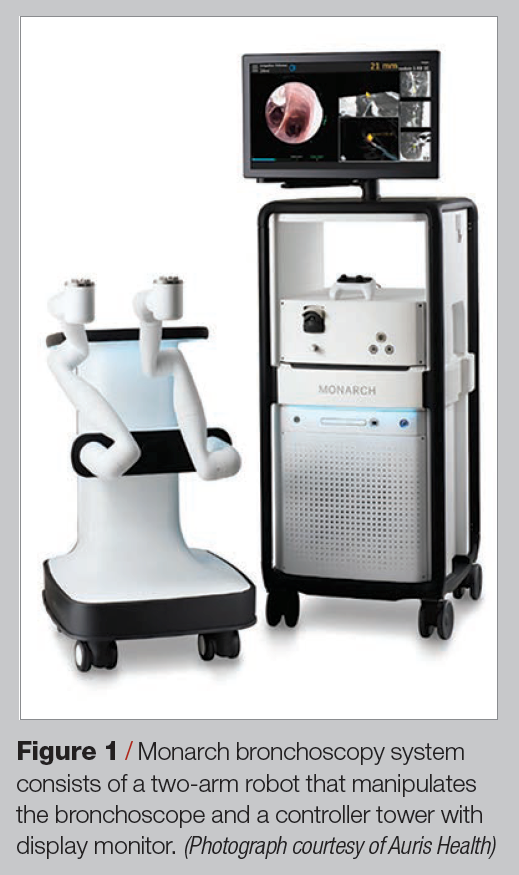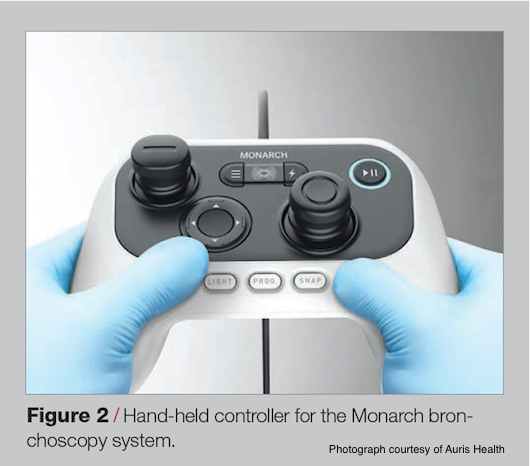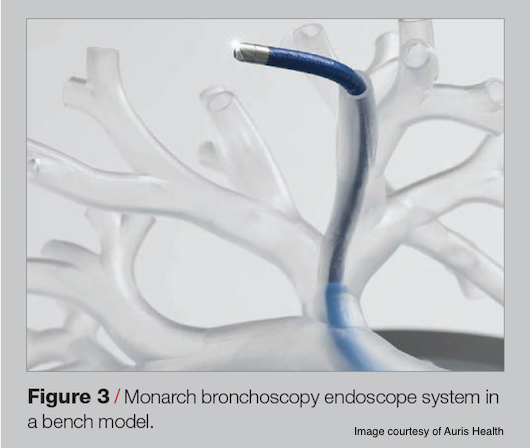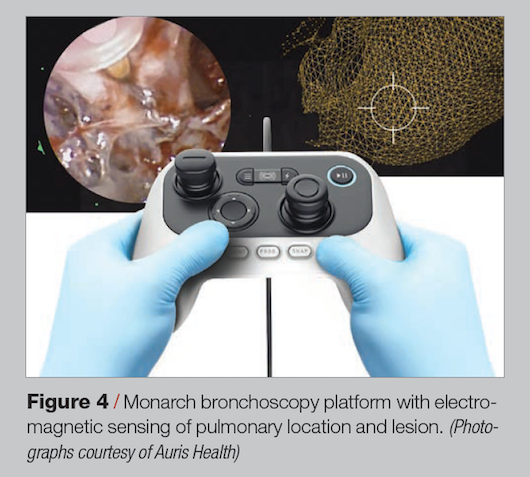Article
Robotic ureteroscopy: The future of stone management?
Author(s):
Advances in robotic URS will help target stones and reduce ionizing radiation.
Robotics has become commonplace in urology, particularly in robot-assisted surgery. It has facilitated the spread of laparoscopy to enable surgeons who were not originally trained in laparoscopic surgery and also improved surgeon ergonomics, if not patient outcomes.
While patients have demonstrated quicker times to return of urinary continence after robot-assisted laparoscopic prostatectomy (RALP), there has been no real difference in long-term survival or positive surgical margin rate. This equivalence is acceptable compared to standard open radical prostatectomy; additionally, robot-assisted laparoscopy may make it easier for the surgeon to operate in the pelvis given that he or she can use three-dimensional vision, magnification, and movement scaling with instruments that have six degrees of freedom compared to only four degrees of freedom in laparoscopic instruments. RALP has become the standard for radical prostatectomy in the United States and many other parts of the world, as rates of open prostatectomy have declined by over 70% in the past few years (Mayo Clin Proc 2016; 91:1-2).
Also see: Stone management often falls short
Ureteroscopy has been used commonly for stone removal since the 1990s, particularly with the widespread adoption of the holmium:YAG laser for lithotripsy. Challenges have included transitioning from semi-rigid ureteroscopy to flexible ureteroscopy. Rigid ureteroscopes were initially designed by Dr. Demetrius Bagley and ACMI and had a short learning curve for urologists who were already familiar with rigid cystoscopy.
When flexible ureteroscopes became available, a new skill set for urologists to learn became apparent, particularly for those not familiar with flexible cystoscopy. As a result, flexible ureteroscopy was only adopted by a portion of urologists and sometimes with a wide range of success and differences in complications (Scand J Urol Nephrol 1988; 22:179-82).
In addition to requiring a new skill set, the cost of flexible ureteroscopy often prohibited its everyday use in certain regions. This financial barrier resulted in an evolution of miniature-sized percutaneous nephrolithotomy (PCNL) instruments: super mini-perc, ultra mini-perc, super ultra-mini perc, etc. Techniques were developed to bypass the need for retrograde flexible ureteroscopy and instead offered percutaneous access using rigid instruments with laser lithotripsy and basketing.
Next: An opportunity for robotics in URSAn opportunity for robotics in URS
While these mini-perc options offer fewer complications than full-sized PCNL, they are still more invasive than ureteroscopy and carry a higher potential for renal bleeding (Urolithiasis 2017; 45:585-9). Flexible ureteroscopy is starting to penetrate these areas, but the skills necessary to make this an effective and reproducible modality must still be learned and mastered. This presents an opportunity where robotic assistance in flexible ureteroscopy could make a big difference by offering the same enabling assistance that robots did for laparoscopic surgery. Robotic ureteroscopy may make novice ureteroscopists excel at flexible ureteroscopy and create opportunities for patients to benefit from minimally invasive approaches to their stone disease.

The Roboflex (ELMED) was one of the first robots used for ureteroscopy and it utilized a robotic control and interface that interfaced and docked with a standard flexible fiberoptic ureteroscope (Eur Urol 2014; 66:1092-100). While not having to contort their hands, wrists, or limbs and being able to stand further back from the C-arm radiation source were accompanying advantages of this robot, the surgeon was still limited within the confines of the limitations of the existing ureteroscope movement. Newer robotic endosocopes may have more degrees of freedom, just as robotic instruments developed “wrists,” and may be more akin to an elephant’s proboscis that can twist and reach more places.
Read: New agents may offer hope for two forms of hyperoxaluria
Auris Health, Inc. is pioneering robotic endoscopy in a different way by developing its own endoscope technologies and integrating additional technologies that enhance a surgeon’s capabilities. The company’s Monarch Platform is currently approved for robotic bronchoscopy (figure 1), and the instruments and platform could be adjusted for endourology. In fact, the company has signaled interest in endourologic stone management from recent publications(J Bronchology Interv Pulmonol 2018; 25:168-75; J Urol 2011; 186:563-8).

The Auris Monarch Platform for bronchoscopy utilizes an ergonomic and easy-to-understand hand controller similar to those used in modern video games (figure 2). By offering additional range of motion at the endoscope tip, controlled through a familiar interface, a robotic ureteroscopy system has the potential to improve the learning curve of the novice flexible ureteroscopist (figures 3 and 4).
Insertion of guidewires and ureteral access sheaths are basic skills that are already within urologists’ skill sets. Once access to the ureter and kidney have been achieved, often the most difficult aspect is controlling a flexible ureteroscope in the kidney, particularly in the lower pole. By having a computer and robot functioning as a follower to the urologist’s commands, it simply becomes a matter of advancing or rotating a controller and deciding where to go.
Advantages of robotic systems
Several advantages could theoretically be added to such systems. First, ureteroscope manipulation takes time to learn-usually the course of an entire residency-that there is rotation, pitch, yaw, and advance/regress on the ureteroscope handle. To complicate these movements further, there is also the deflection of the tip using the thumb lever. One must learn to simultaneously control several variables in order to arrive at a certain location. With a game controller in hand, the surgeon must simply decide which calyx they want to enter and use the joystick to advance there while the computer calculates the amount of roll, torque, pitch, and yaw in order to get there.

In addition, force sensors could be utilized so that the ureteroscope cannot perforate the renal pelvis, thus increasing safety. If 3-D vision is applied to future ureteroscopy robots, it could also enhance manipulation and visualization. With placement of instruments in the kidney, electromagnetic sensors (EM) could be correlated with the CT preoperatively and therefore a 3-D GPS-like map could be displayed without the use of ionizing radiation, thus minimizing fluoroscopy (Urology Nov 14, 2019 [Epub ahead of print]). The surgeon would always be able to know which calyx the endoscope was in by simply looking at a heads-up-display. EM sensing positioning technology has been used in the robotic bronchoscopy system. If real-time ultrasound was added, this could also help guide surgeons to any remaining stones or fragments that have been displaced during the procedure.
A robot-assisted platform could allow the laser fiber or instrument to be fine-tuned with precision using the robot and controller. Ultimately, a robot could theoretically control the ureteroscope and synchronize it with respiration during laser lithotripsy to increase the efficiency of fragmentation. Baskets could be controlled by a robotic system and be used to pull the ureteroscope out of the access sheath, drop the stone, and then return to the exact previous spot since it will remember the location in all vectors.
The obvious safety concern with this use is pulling out a stone that does not fit the sheath and avulsing the ureter. The robot could address this in two ways. First, endoscopic measurement of the stone fragments could be made to ensure that the pieces are small enough to fit through the access sheath. Second, force sensors could be incorporated into the system to prevent ureteral avulsion; it would simply stop retracting and the surgeon would be able to further fragment the stone before extraction.

Laser settings could also be programmed into the robot, and instead of the surgeon stopping to alter the settings, the robot could constantly monitor the types of dust or fragment being produced and the amount of retropulsion or stone movement, then alter the settings as lithotripsy is taking place and the stone is decreasing in mass. Of course, the surgeon would be able to determine at the onset whether the stone should be dusted or fragmented with basket extraction, all while eliminating the need for or reliance on an assistant.
Once synchronization of respiratory movements can be accounted for, this may make lithotripsy very fast and efficient. Ultimately, it is conceivable that the surgeon would place a target on the stone in question, hit a “start” button, and then the robot would control the laser, ureteroscope, fluid irrigation, and laser settings to reduce retropulsion and adjust for respiratory movements to break up the stone into dust. This would all take place while the surgeon stands by at the console.
Conclusion
New robotic technologies will improve the ability of novice ureteroscopists to provide excellent treatment of renal stones and also improve the ability of experts to target stones with better surgeon ergonomics while reducing ionizing radiation from fluoroscopy. The future is bright, and we are at the dawn of the next era of robot-assisted ureteroscopy.

Dr. Chew is associate professor of urologic sciences at the University of British Columbia, Vancouver, and chair of research for the Endourological Society. Dr. Chi is associate professor of urology, University of California, San Francisco. Dr. Monga is director of the Stevan B. Streem Center for Endourology & Stone Disease at Cleveland Clinic. Dr. Humphreys is professor and chair of urology, Mayo Clinic, Phoenix. Dislcosures: Drs. Chew, Chi, Monga, and Humphreys are consultants to Auris Surgical.

Section Editor James M. Hotaling, MD, MS

Section Editor Steven A. Kaplan, MD
James M. Hotaling, MD, is assistant professor of surgery (urology) at the Center for Reconstructive Urology and Men’s Health, University of Utah, Salt Lake City, and Steven A. Kaplan, MD, is professor of urology, Icahn School of Medicine at Mount Sinai, New York.
















